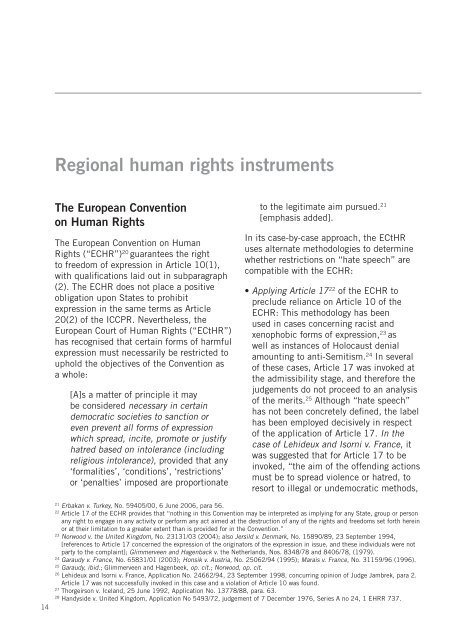ARTICLE-19-policy-on-prohibition-to-incitement
ARTICLE-19-policy-on-prohibition-to-incitement
ARTICLE-19-policy-on-prohibition-to-incitement
Create successful ePaper yourself
Turn your PDF publications into a flip-book with our unique Google optimized e-Paper software.
Regi<strong>on</strong>al human rights instruments<br />
The European C<strong>on</strong>venti<strong>on</strong><br />
<strong>on</strong> Human Rights<br />
The European C<strong>on</strong>venti<strong>on</strong> <strong>on</strong> Human<br />
Rights (“ECHR”) 20 guarantees the right<br />
<strong>to</strong> freedom of expressi<strong>on</strong> in Article 10(1),<br />
with qualificati<strong>on</strong>s laid out in subparagraph<br />
(2). The ECHR does not place a positive<br />
obligati<strong>on</strong> up<strong>on</strong> States <strong>to</strong> prohibit<br />
expressi<strong>on</strong> in the same terms as Article<br />
20(2) of the ICCPR. Nevertheless, the<br />
European Court of Human Rights (“ECtHR”)<br />
has recognised that certain forms of harmful<br />
expressi<strong>on</strong> must necessarily be restricted <strong>to</strong><br />
uphold the objectives of the C<strong>on</strong>venti<strong>on</strong> as<br />
a whole:<br />
[A]s a matter of principle it may<br />
be c<strong>on</strong>sidered necessary in certain<br />
democratic societies <strong>to</strong> sancti<strong>on</strong> or<br />
even prevent all forms of expressi<strong>on</strong><br />
which spread, incite, promote or justify<br />
hatred based <strong>on</strong> in<strong>to</strong>lerance (including<br />
religious in<strong>to</strong>lerance), provided that any<br />
‘formalities’, ‘c<strong>on</strong>diti<strong>on</strong>s’, ‘restricti<strong>on</strong>s’<br />
or ‘penalties’ imposed are proporti<strong>on</strong>ate<br />
<strong>to</strong> the legitimate aim pursued. 21<br />
[emphasis added].<br />
In its case-by-case approach, the ECtHR<br />
uses alternate methodologies <strong>to</strong> determine<br />
whether restricti<strong>on</strong>s <strong>on</strong> “hate speech” are<br />
compatible with the ECHR:<br />
• Applying Article 17 22 of the ECHR <strong>to</strong><br />
preclude reliance <strong>on</strong> Article 10 of the<br />
ECHR: This methodology has been<br />
used in cases c<strong>on</strong>cerning racist and<br />
xenophobic forms of expressi<strong>on</strong>, 23 as<br />
well as instances of Holocaust denial<br />
amounting <strong>to</strong> anti-Semitism. 24 In several<br />
of these cases, Article 17 was invoked at<br />
the admissibility stage, and therefore the<br />
judgements do not proceed <strong>to</strong> an analysis<br />
of the merits. 25 Although “hate speech”<br />
has not been c<strong>on</strong>cretely defined, the label<br />
has been employed decisively in respect<br />
of the applicati<strong>on</strong> of Article 17. In the<br />
case of Lehideux and Isorni v. France, it<br />
was suggested that for Article 17 <strong>to</strong> be<br />
invoked, “the aim of the offending acti<strong>on</strong>s<br />
must be <strong>to</strong> spread violence or hatred, <strong>to</strong><br />
resort <strong>to</strong> illegal or undemocratic methods,<br />
14<br />
21<br />
Erbakan v. Turkey, No. 59405/00, 6 June 2006, para 56.<br />
22<br />
Article 17 of the ECHR provides that “nothing in this C<strong>on</strong>venti<strong>on</strong> may be interpreted as implying for any State, group or pers<strong>on</strong><br />
any right <strong>to</strong> engage in any activity or perform any act aimed at the destructi<strong>on</strong> of any of the rights and freedoms set forth herein<br />
or at their limitati<strong>on</strong> <strong>to</strong> a greater extent than is provided for in the C<strong>on</strong>venti<strong>on</strong>.”<br />
23<br />
Norwood v. the United Kingdom, No. 23131/03 (2004); also Jersild v. Denmark, No. 15890/89, 23 September <str<strong>on</strong>g>19</str<strong>on</strong>g>94,<br />
[references <strong>to</strong> Article 17 c<strong>on</strong>cerned the expressi<strong>on</strong> of the origina<strong>to</strong>rs of the expressi<strong>on</strong> in issue, and these individuals were not<br />
party <strong>to</strong> the complaint]; Glimmerveen and Hagenback v. the Netherlands, Nos. 8348/78 and 8406/78, (<str<strong>on</strong>g>19</str<strong>on</strong>g>79).<br />
24<br />
Garaudy v. France, No. 65831/01 (2003); H<strong>on</strong>sik v. Austria, No. 25062/94 (<str<strong>on</strong>g>19</str<strong>on</strong>g>95); Marais v. France, No. 31159/96 (<str<strong>on</strong>g>19</str<strong>on</strong>g>96).<br />
25<br />
Garaudy, ibid.; Glimmerveen and Hagenbeek, op. cit.; Norwood, op. cit.<br />
26<br />
Lehideux and Isorni v. France, Applicati<strong>on</strong> No. 24662/94, 23 September <str<strong>on</strong>g>19</str<strong>on</strong>g>98, c<strong>on</strong>curring opini<strong>on</strong> of Judge Jambrek, para 2.<br />
Article 17 was not successfully invoked in this case and a violati<strong>on</strong> of Article 10 was found.<br />
27<br />
Thorgeirs<strong>on</strong> v. Iceland, 25 June <str<strong>on</strong>g>19</str<strong>on</strong>g>92, Applicati<strong>on</strong> No. 13778/88, para. 63.<br />
28<br />
Handyside v. United Kingdom, Applicati<strong>on</strong> No 5493/72, judgement of 7 December <str<strong>on</strong>g>19</str<strong>on</strong>g>76, Series A no 24, 1 EHRR 737.


